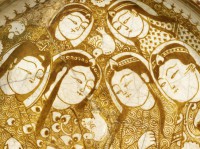Islamic Ceramics trail
Explore over one thousand years of development in Islamic ceramics through our extensive collection.

- This is a visual browsing tool that maps objects in this publication, gallery or collection trail by date of creation onto a timeline.
- The circular markers indicate where objects are on the timeline.
- The size of the markers indicates the relative number of objects at that point on the timeline.
- Hover over a marker to find out which objects are represented at that point in time.
- To expand, collapse or hide the timeline, click these symbols
 found at the top right of the timeline.
found at the top right of the timeline.
- 780
- 820
- 860
- 900
- 940
- 980
- 1020
- 1060
- 1100
- 1140
- 1180
- 1220
- 1260
- 1300
- 1340
- 1380
- 1420
- 1460
- 1500
- 1540
- 1580
- 1620
Fritware
The development of a new ceramic body, usually referred to as fritware or stonepaste, revolutionized ceramics manufacture in the Islamic lands. It was largely made of quartz, with smaller amounts of glass and fine white clay.
Fritware appeared in its most refined form in Syria and Iran in the 12th century, but potters in Egypt had been experimenting with it since at least the previous century. The arrival in the Middle East of a new fine Chinese porcelain at this time probably influenced its refinement. Islamic potters used it creatively as a background for a variety of incised, moulded and painted decoration.
 Jug with epigraphic decoration (EAX.3110)
Jug with epigraphic decoration (EAX.3110)
 Ewer with chain-like decoration and faceted spout (EA1978.2275)
Ewer with chain-like decoration and faceted spout (EA1978.2275)
 Fragment of a dish with peacock (EA1978.2177)
Fragment of a dish with peacock (EA1978.2177)
Lustre development
First used in 9th-century Iraq, and developed further in Egypt during the 10th and 11th centuries, lustre painting flourished in Iran and Syria in the late-12th and 13th centuries. It was greatly disrupted, however, by the Mongol invasions in the second quarter of the 13th century, as was the ceramics industry as a whole. Lustreware production only resumed fully in the second half of the century.
 Bowl with riders in a landscape (EA1956.28)
Bowl with riders in a landscape (EA1956.28)
 Bowl with seated figures by a stream (EA1956.33)
Bowl with seated figures by a stream (EA1956.33)
 Bowl with vegetal and epigraphic decoration (EA1978.2175)
Bowl with vegetal and epigraphic decoration (EA1978.2175)
Overglaze painting
At this same time, potters in Iran developed a new type of overglaze painted decoration, applying enamels over the transparent glaze. As with lustre, the enamels (usually red and black) and occasionally gilding, were applied to the surface of vessels that had already been glazed, and fixed with a second gentle firing. To date, the city of Kashan in Iran is the only identified centre of manufacture of this enamel-painted ware.
Underglaze painting
By the turn of the 13th century, another technique that would dominate all future pottery production in the Islamic lands was fully developed – underglaze painting. Its gradual development is best seen in Iran, where potters initially experimented with the application of a black slip under the glaze (so-called ‘silhouette’ ware) until they obtained full control over thin pigments which would not run during the firing. The earliest dated examples of Iranian manufacture are from the early 13th century. Syria and Egypt were manufacturing fine underglaze painted ware at the same time.
© 2013 University of Oxford - Ashmolean Museum




